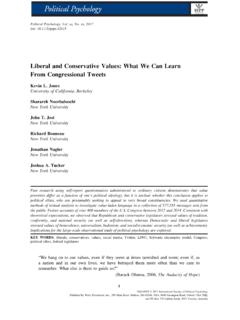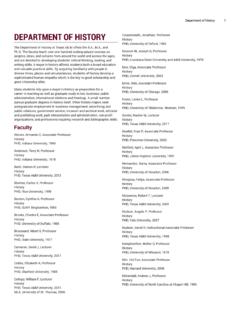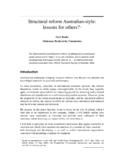Transcription of Seat Distribution in the House of Commons: Alternatives to ...
1 Seat Distribution in the House of Commons: Alternatives to C-20 Bill C-20, an Act meant to ensure "fair representation of the provinces in the House of Commons, contains a major flaw: it would needlessly increase the number of MPs from 308 to 338, as well as the cost associated with adding these new seats. Canadians are concerned about the additional cost of such an inflationary measure. The government's new proposal sends the wrong message: that it wants to gorge itself with more politicians while it slashes the public service and services to the public! This makes no sense. In these days of financial restraint, Parliament must take the lead. As Liberal Leader Bob Rae recently insisted, the number of MPs cannot keep growing forever.
2 We already have a higher MP-to-population ratio than is the norm in other democracies. Let's not forget that in our decentralized federation, there are many pressing issues such as schools and hospitals that members of Parliament don't have to address. Australians do very well with their 150 federal MPs. In the United States, a country almost ten times as populous as ours, the House of Representatives is limited to 435 seats. Currently, Canada is the only federation that deems it necessary to increase its number of federal MPs every time there is a need to rebalance regional representation in Parliament. This is an unnecessary and unsustainable practice. We must put a stop to it the sooner, the better.
3 Stephen Harper would have liked that to occur in 1994. As a Reform Party MP, he declared that a smaller House offers considerable cost savings and that Canadians are already among the most overrepresented people in the world 1 We can easily rebalance the House 's seat allocation, in order to address the needs of the provinces with strong population growth while maintaining proportionate representation of the other provinces, without raising the total number of MPs. Some provinces will then have fewer MPs than they have now. But what is important is not the absolute number of seats; it's the number relative to the whole. This is the reasoning adopted today by other democracies, and that also applied to Canada not so long ago.
4 So why not return to this common sense position? The attached table compares current seat Distribution with one possible, cost-saving, alternative proposal. It shows that we can achieve the same proportionate number of MPs per province with the existing number of 308 seats. There is no need to raise the number to 338. By keeping the number of MPs at 308, this alternative option also has 1 Procedure and House Affairs Committee, 25-11-1994, pp. 33: 38-39. the benefit of saving Canadian taxpayers an estimated $86 million at a minimum, over the course of the next election cycle. This result is achieved thanks to a much simpler formula than the government's very complicated scheme.
5 In this proposal, proportionate seat representation (based on the July, 2011 Statistics Canada data) is modulated via the Constitutional rule outlined in section 51(A) of the Constitution Act, which says that a province cannot hold less MPs than Senators. Since the law also applies to the Territories, they have been included in our calculations; there is no reason, Constitutional or other, not to do so. Then we apply the government s proposed Representation Rule , which ensures that any currently overrepresented province does not become underrepresented. However, we propose replacing the so-called "grandfather clause" with a rule, that was used in the 1950s, that says a province cannot lose more than 15% of its seats as a result of a redistribution exercise.
6 This way, we can ensure that any reduction remains modest. Let us not forget that this grandfather clause, which stops us from reducing the number of federal MPs representing a province, can be revised by Parliament since it is Parliament that enacted it in 1985. The application of the 15% rule and the requirement to ensure that no province has fewer MPs than Senators results in a total of 324 seats. Finally, the 16 seats in excess of 308 seats are deducted from the total seats belonging to the three provinces with strong population growth. Each province s portion of the deduction is equivalent to its percentage of the total seat count of those provinces. The result is a 308-seat House of Commons.
7 That's how we can achieve a fair and balanced House of Commons without adding any seats. St phane Dion Member of Parliament for Saint-Laurent Cartierville Table 1 Current seat Status quo Population Distribution (1985 formula) PROVINCE OR TERRITORY SEATS % TOTAL Seats % Total % Ontario 106 109 Quebec 75 75 British Columbia 36 37 Alberta 28 31 Manitoba 14 14 Saskatchewan 14 14 Nova Scotia 11 11 New Brunswick 10 10 Newfoundland and Labrador 7 7 Prince Edward Island 4 4 North West Territories 1 1 Yukon 1 1 Nunavut 1 1 TOTAL 308 100% 315 100% 100% *Based on Statistics Canada's Population Estimate as of July 1, 2011 Table 2 House : House .
8 Population Government Bill Equitable Plan PROVINCE OR TERRITORY SEATS % TOTAL SEATS % TOTAL % Ontario 121 110 Quebec 78 72 British Columbia 42 38 Alberta 34 31 Manitoba 14 12 Saskatchewan 14 12 Nova Scotia 11 10 New Brunswick 10 10 Newfoundland and Labrador 7 6 Prince Edward Island 4 4 North West Territories 1 1 Yukon 1 1 Nunavut 1 1 TOTAL 338 100% 308 100% 100% *Based on Statistics Canada's Population Estimate as of July 1, 2011







